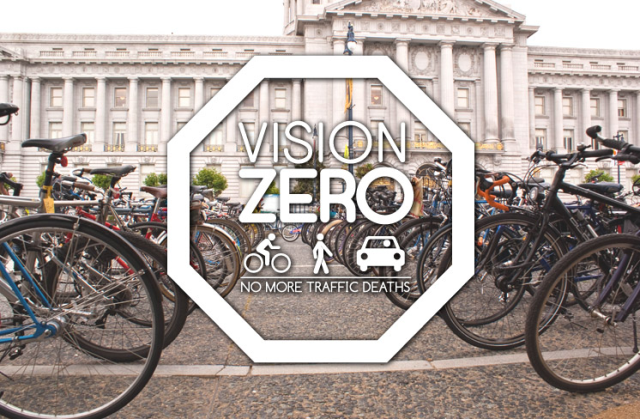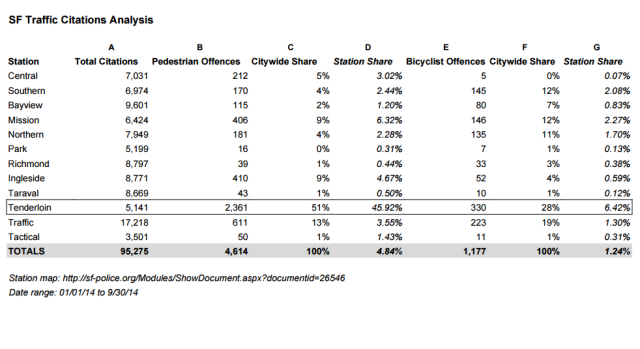There are good reasons for people to worry about the way the cops are enforcing Vision Zero

by Fran Taylor
The deaths of Sandra Bland in Texas and Samuel DuBose in Ohio following police stops for failing to signal a lane change and lacking a front license plate highlight the dangers of relying on law enforcement to rectify social ills.
While traffic violence in San Francisco leads to three pedestrian injuries every day and 11 pedestrian fatalities so far in 2015, those of us involved in the Vision Zero campaign to stop this violence must be wary of unleashing another form of violence on populations typically singled out for selective law enforcement.
Meanwhile, the San Francisco Police Department is using Vision Zero as a pretext to target the typical victims of traffic violence: pedestrians and bicyclists. While getting a ticket is less serious than dying after police intervention, both exist on a continuum of profiling and misuse of power. This juxtaposition creates an opportunity for groups that may not speak much to each other—transportation advocates and communities of color—to acknowledge each other’s struggle and find common ground. It’s up to all of us to seize this opportunity and broaden our frames of reference.
Black and brown communities in San Francisco have every reason to be skeptical of a campaign like Vision Zero that could give police a new excuse to harass them, especially in light of the recent deaths of Alex Nieto on Bernal hill and Amilcar Perez-Lopez in the Mission at the hands of the SFPD. Watching videos of Sandra Bland and Samuel DuBose being pulled over for minor traffic offenses and winding up dead must send a chill to anyone hearing calls for increased police enforcement.
Exacerbating this atmosphere of distrust is the intentional police misinterpretation of Vision Zero that has already taken place in San Francisco. Reliable data have shown that five behaviors—red-light running, speeding, stop sign running, failure to yield, and violating pedestrian right of way—cause the most mayhem on our streets. Even though all of the offenses making up “Focus on the Five” consist of driver fault, some police officials have used Vision Zero to justify ticketing bicyclists and pedestrians in the Tenderloin as well as along the Wiggle.

Vision Zero advocates must remain steadfast in our efforts to eliminate traffic deaths and serious injuries by 2024. Fortunately, we have other means to reach this goal that do not require police intervention: reengineering streets so that they no longer encourage speeding; enhancing pedestrian and bicycle infrastructure; and providing education to all members of the public, no matter how they get around.
But enforcement cannot be avoided altogether. We all see every day drivers whip around turns without slowing, forcing people to jump out of the way; speed on neighborhood streets where children may be playing; or gun it through red lights. When police ignore these dangerous moves and instead pounce on so-called jaywalkers or hound a youth of color for no good reason, we are left doubly unprotected.
To add insult to injury, the populations most likely to be racially profiled are also those most likely to be injured or killed by traffic violence. Nationally, African Americans have a pedestrian fatality rate 60% higher than that of whites. For Latinos, that rate is 43% higher. At the same time, nearly 75% of black respondents in a recent survey consider violence against civilians by law enforcement to be a serious problem, compared with less than 20% of whites. This disconnect could lead Vision Zero to alienate the very neighborhoods that it could help the most by identifying the campaign with heavy-handed police behavior.
City Hall and the San Francisco Police Department have been silent or insulting on these contradictions. The community-based Vision Zero Coalition and the more city agency–heavy Vision Zero Task Force, as well as transportation advocacy groups such as Walk San Francisco and the San Francisco Bicycle Coalition, must instead look beyond our own members and encourage all San Franciscans concerned about both traffic violence and police violence to help us address this problem.
Now is a perfect time for bicyclists and pedestrians who may newly understand how it feels to be targeted unfairly to wake up to other forms of police profiling. As we continue with our work, we need to keep our eyes and ears open to the possibility of unintended consequences. Vision Zero can’t let itself become a rationale for open season on drivers of color.




